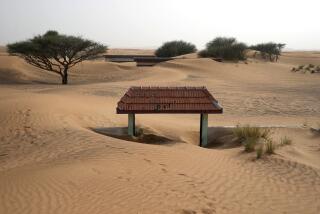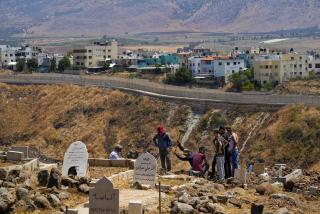In Sri Lanka, Strife in the Village of Saddam Hussein
- Share via
SADDAM HUSSEIN, Sri Lanka — Tucked away among palm trees and fertile rice fields, the village of Saddam Hussein stands as a grim reminder of the bloody violence sweeping the Tamil and Muslim communities of eastern Sri Lanka.
Six hundred families once lived in Saddam Hussein village, built in 1982 with funds from the Iraqi government and named after its president.
Today, its dusty streets and houses are deserted. Its population fled after they were chased away by the Tamil Tiger guerrillas, who are fighting the Sri Lankan government for an independent homeland.
Crowded into refugee camps, the angry Muslims claim that the man their village is named after gives them the inspiration for their jihad (holy war) against the Tamils.
“We have had enough of the Tamils,” says Muhammad Rashif, a former resident of the village. “We are fighting to make Islam strong once again.”
Gun battles between armed Muslims and Tamil guerrillas take place daily as the two sides carry out a series of reprisal attacks. The predominantly Hindu Tamils are abducted if they venture into Muslim areas. The Muslims, many of whom are farmers, are shot if they stray into Tamil territory. Muslim youths have also formed clandestine hit squads to carry out attacks.
The result is the emergence of an ethnic apartheid with the two communities estranged and polarized.
Violence between the two communities first flared last August, after 300 Muslims were killed in a series of massacres by suspected Tamil Tigers.
Muslims have traditionally made up a nonpolitical, prosperous business community and have not been involved in Sri Lanka’s ethnic politics. But the massacres sparked a new-found militancy among Sri Lanka’s Muslims, which is drawing much of its strength from the worldwide growth in Islamic fundamentalism and the Persian Gulf crisis.
“Saddam is our hero. He is fighting for Islam and we look to his example,” says Faroq Talfiq, a teacher in the Muslim town of Eravur in eastern Sri Lanka.
The violence also marks a significant shift in Sri Lanka’s ethnic crisis. Muslims and Tamils have always lived side by side in eastern parts of the island, where Muslims, who are the descendants of Arab traders, make up 35% of the 1.2-million population.
As the violence between Muslims and Tamils escalates, leaders of the Muslim community have already begun asking for regional autonomy for their people.
More to Read
Sign up for Essential California
The most important California stories and recommendations in your inbox every morning.
You may occasionally receive promotional content from the Los Angeles Times.













